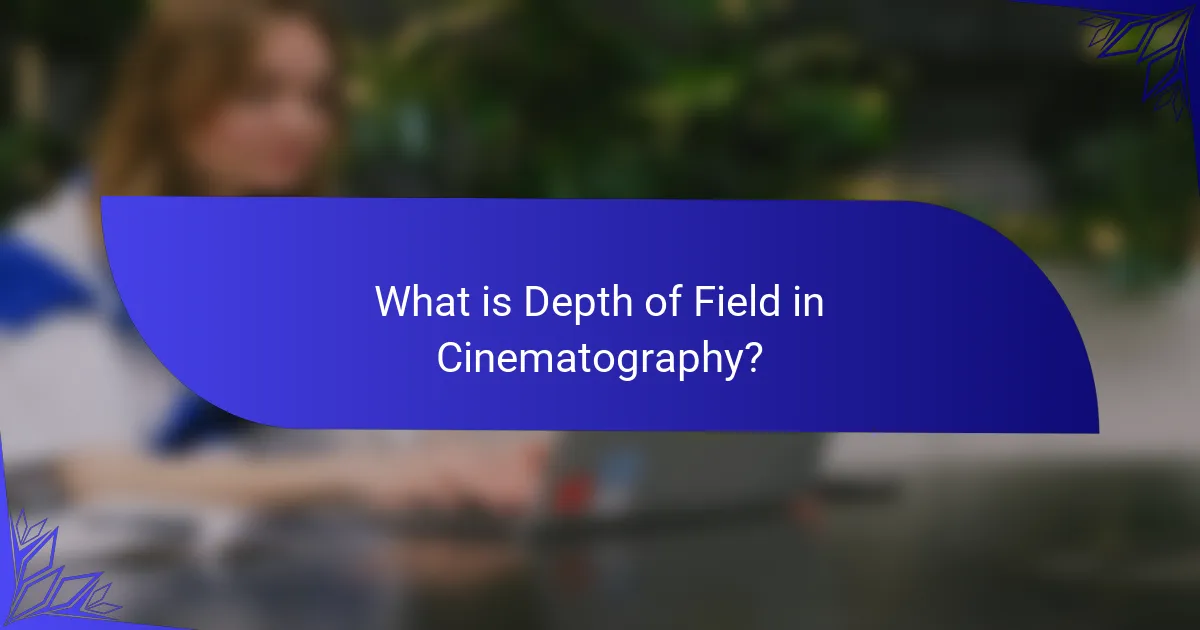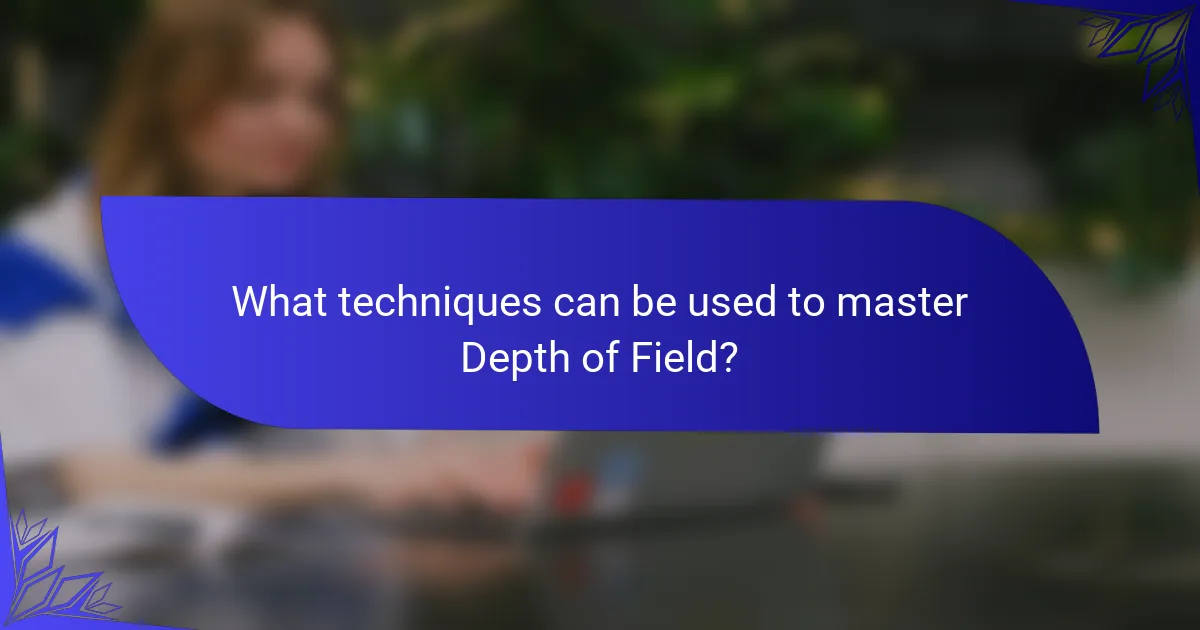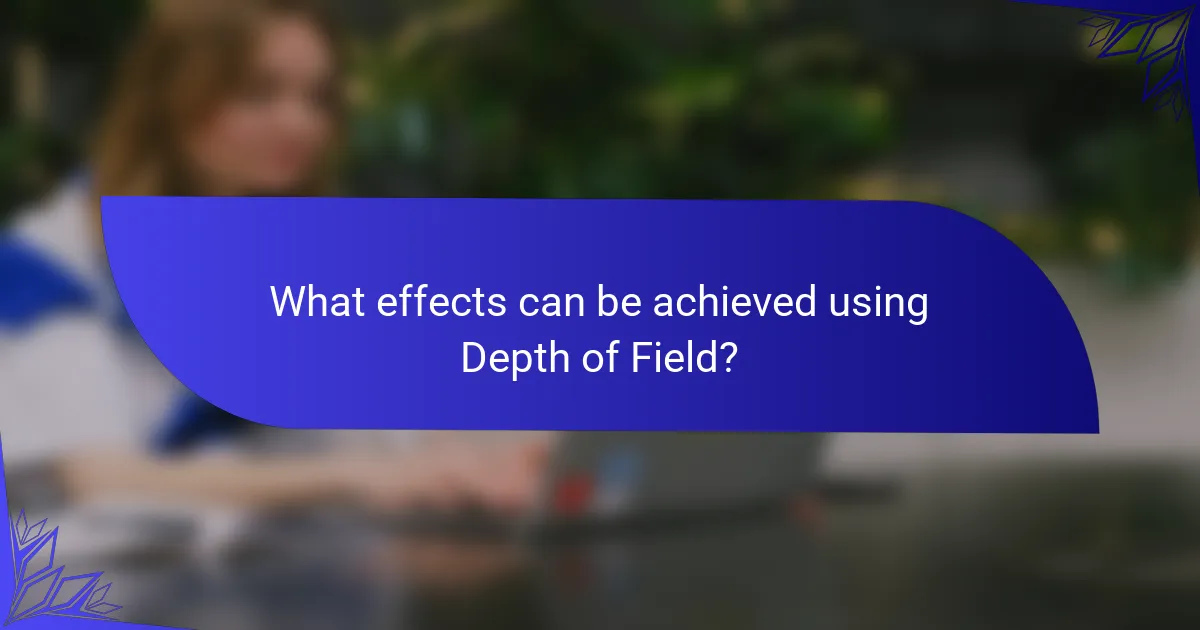Depth of field (DoF) in cinematography is the range of distance in a scene that appears sharp, influenced by factors such as aperture, focal length, and subject distance. This article explores techniques for mastering depth of field, including adjusting aperture settings and focal lengths to achieve desired visual effects. It discusses the impact of shallow and deep depth of field on storytelling, viewer attention, and emotional engagement. Additionally, the article highlights practical methods for manipulating focus, such as using focus pulling and varying camera distance, to enhance cinematic visuals.

What is Depth of Field in Cinematography?
Depth of field in cinematography refers to the range of distance within a scene that appears acceptably sharp. It is influenced by factors such as aperture, focal length, and distance from the subject. A shallow depth of field isolates the subject by blurring the background. Conversely, a deep depth of field keeps more of the scene in focus. Cinematographers manipulate depth of field to enhance storytelling and visual aesthetics. For instance, wide apertures create a shallow depth of field, while narrow apertures achieve a deeper focus. This technique is essential in guiding the viewer’s attention and creating mood.
How does Depth of Field affect visual storytelling?
Depth of Field (DoF) significantly influences visual storytelling by controlling focus and perspective. It helps to direct the audience’s attention to specific elements within a scene. A shallow depth of field isolates subjects, creating emotional intimacy. This technique enhances the viewer’s connection with characters or key actions. Conversely, a deep depth of field allows for broader context, establishing the environment and relationships. This can convey themes of isolation or vastness. Studies show that filmmakers use DoF to evoke specific emotional responses. For example, in “The Graduate,” shallow focus emphasizes emotional tension between characters. Thus, DoF is a critical tool in shaping narrative and viewer experience.
What are the different ranges of Depth of Field?
Depth of Field (DoF) ranges can be classified into three categories: shallow, medium, and deep. Shallow DoF focuses on a small area, blurring the background and foreground. It is often used in portrait photography to isolate subjects. Medium DoF provides a balance, keeping both the subject and some background details in focus. This range is commonly used in landscape photography. Deep DoF keeps most of the scene in focus, ideal for wide landscapes or architectural shots. Each range influences the viewer’s attention and perception of the scene.
How does Depth of Field influence audience perception?
Depth of Field (DoF) significantly influences audience perception by controlling focus and visual emphasis. A shallow DoF isolates subjects, directing attention to them while blurring the background. This technique creates intimacy and emotional connection with the viewer. Conversely, a deep DoF includes more elements in focus, providing context and a sense of space. This can evoke feelings of vastness or complexity in a scene. Research shows that visual focus impacts emotional responses; for example, studies indicate that viewers engage more with close-up shots. The choice of DoF shapes narrative interpretation and viewer engagement, guiding emotional responses throughout the film.
Why is Depth of Field important in cinematography?
Depth of Field is important in cinematography because it influences the viewer’s focus and perception. It determines which elements in a scene are sharp and which are blurred. A shallow depth of field isolates subjects, creating emotional impact. This technique is often used in close-up shots to emphasize characters. Conversely, a deep depth of field keeps multiple elements in focus, providing context. This is effective in wide shots to showcase environments. Cinematographers manipulate depth of field to enhance storytelling. It guides audience attention and shapes narrative interpretation.
What role does Depth of Field play in composition?
Depth of Field (DoF) plays a crucial role in composition by influencing focus and visual storytelling. It determines which elements in a scene are sharp and which are blurred. A shallow DoF isolates subjects, drawing attention to them. This technique enhances emotional impact and conveys intimacy. Conversely, a deep DoF keeps more elements in focus, providing context and detail. It is often used in landscape cinematography to showcase expansive scenes. The choice of DoF can significantly alter the viewer’s perception and engagement with the narrative. Research indicates that effective use of DoF can enhance audience immersion and understanding of the story being told.
How can Depth of Field enhance emotional impact?
Depth of field enhances emotional impact by directing viewer attention and creating intimacy. A shallow depth of field isolates subjects, making them stand out against blurred backgrounds. This technique evokes feelings of closeness and vulnerability. Conversely, a deep depth of field can convey a sense of vastness or isolation. By including more elements in focus, it can create a complex emotional landscape. Cinematic examples show how filmmakers use these techniques to manipulate audience emotions effectively. For instance, in “The Tree of Life,” shallow depth of field emphasizes personal moments, heightening emotional resonance.

What techniques can be used to master Depth of Field?
To master Depth of Field, utilize techniques such as adjusting aperture settings, changing focal length, and manipulating subject distance. A wider aperture (lower f-stop number) decreases depth of field, creating a blurred background. Conversely, a narrower aperture (higher f-stop number) increases depth of field, keeping more of the scene in focus. Using a longer focal length lens compresses the background, enhancing the shallow depth of field effect. Shortening the distance between the camera and the subject also reduces depth of field, emphasizing the subject more. Additionally, employing focus pulling can direct audience attention, further mastering depth of field.
How do aperture settings influence Depth of Field?
Aperture settings directly influence depth of field in photography and cinematography. A wider aperture (lower f-stop number) results in a shallower depth of field. This allows for a blurred background, isolating the subject. Conversely, a narrower aperture (higher f-stop number) increases depth of field. This keeps more of the scene in focus, suitable for landscapes or group shots.
The relationship between aperture and depth of field is a fundamental aspect of exposure triangle. A study published in the Journal of Visual Communication and Image Representation demonstrates that changing aperture settings alters the perception of focus in an image. This effect is critical for achieving specific artistic and narrative goals in cinematography.
What are the effects of different f-stop values?
Different f-stop values affect exposure and depth of field in photography and cinematography. Lower f-stop values, such as f/1.4, allow more light to enter the lens. This results in brighter images but a shallower depth of field. A shallow depth of field isolates the subject, creating a blurred background. Conversely, higher f-stop values, like f/16, reduce light entering the lens. This results in darker images but a greater depth of field. A greater depth of field keeps more elements in focus, which is useful for landscapes. The choice of f-stop influences both the visual aesthetics and technical aspects of the shot, impacting storytelling and viewer perception.
How does lens choice impact Depth of Field?
Lens choice significantly impacts depth of field in photography and cinematography. Different focal lengths create varying levels of background blur and subject isolation. A wide-angle lens typically offers a greater depth of field, allowing more of the scene to be in focus. Conversely, a telephoto lens reduces depth of field, leading to pronounced background blur.
The aperture setting also interacts with lens choice. A larger aperture (smaller f-stop number) further decreases depth of field, enhancing subject separation. Conversely, a smaller aperture (larger f-stop number) increases depth of field, bringing more elements into focus.
In practical terms, using a 24mm lens at f/8 may yield a sharper background compared to a 200mm lens at f/2.8. This difference is crucial for cinematographers aiming for specific visual effects. Consequently, understanding lens choice is essential for controlling depth of field and achieving desired artistic outcomes.
What camera settings are essential for controlling Depth of Field?
Aperture, focal length, and distance to the subject are essential camera settings for controlling depth of field. Aperture, measured in f-stops, directly influences how much light enters the lens. A lower f-stop number, such as f/2.8, results in a shallower depth of field. Conversely, a higher f-stop number, like f/16, increases depth of field, bringing more elements into focus. Focal length also plays a crucial role; longer focal lengths compress the background, creating a more pronounced blur. Additionally, the distance to the subject affects depth of field; closer subjects yield a shallower depth of field, while subjects further away result in a deeper focus. These relationships are fundamental in cinematography for achieving desired visual effects and focus control.
How can focal length affect Depth of Field?
Focal length directly affects depth of field (DoF) in photography and cinematography. A longer focal length results in a shallower depth of field. This means that less of the scene will be in focus. Conversely, a shorter focal length provides a deeper depth of field. More of the scene appears sharp and clear.
For instance, a 50mm lens at f/2.8 creates a different DoF than a 200mm lens at the same aperture. The 200mm lens will isolate subjects more effectively. This principle is used to create artistic effects in cinematography. It helps direct viewer attention to specific elements within the frame.
In summary, focal length is a key factor in controlling depth of field. Understanding this relationship allows cinematographers to enhance storytelling visually.
What is the significance of sensor size in Depth of Field?
Sensor size significantly affects Depth of Field (DoF) in photography and cinematography. Larger sensors typically produce a shallower DoF. This means that more background blur can be achieved, isolating subjects more effectively. Conversely, smaller sensors tend to yield a deeper DoF. This results in more of the scene being in focus. The relationship between sensor size and DoF is crucial for creative control in visual storytelling. For instance, full-frame sensors allow for greater artistic expression by enabling selective focus. This principle is supported by the physics of optics, where sensor size influences the aperture’s impact on DoF.

What effects can be achieved using Depth of Field?
Depth of Field (DoF) can create various visual effects in cinematography. It influences the focus and clarity of subjects within a frame. A shallow depth of field isolates the subject from the background. This effect emphasizes the subject and creates a sense of intimacy. Conversely, a deep depth of field keeps multiple elements in focus. This technique is useful for establishing context and detail in a scene. Additionally, changes in depth of field can guide viewer attention. By manipulating focus, filmmakers can enhance storytelling. Studies show that depth of field affects emotional response and engagement.
How does Depth of Field create visual focus?
Depth of Field (DoF) creates visual focus by controlling the amount of the scene that appears sharp in an image. A shallow DoF isolates the subject from the background, making it stand out. This is achieved by using a wide aperture, which reduces the area in focus. Conversely, a deep DoF keeps more of the scene in focus, which can be useful for landscapes. The use of DoF guides the viewer’s attention to specific elements within the frame. Cinematographers manipulate DoF to enhance storytelling and emotional impact. Research indicates that viewers are more likely to focus on subjects with shallow DoF, reinforcing its effectiveness in visual composition.
What are the differences between shallow and deep Depth of Field?
Shallow depth of field focuses on a small area of the image, while deep depth of field keeps most of the scene in focus. Shallow depth of field is often used for portraits to isolate the subject from the background. It creates a blurred background effect, enhancing the subject’s presence. Deep depth of field is commonly used in landscape photography, where foreground and background details are equally sharp. This technique allows for a comprehensive view of the scene. The aperture setting significantly influences depth of field. A wider aperture (e.g., f/2.8) results in shallow depth, while a narrower aperture (e.g., f/16) yields deep depth. Understanding these differences helps cinematographers choose the right technique for their narrative.
How can Depth of Field be used to isolate subjects?
Depth of Field can be used to isolate subjects by controlling the area of focus in an image. A shallow Depth of Field blurs the background and foreground while keeping the subject sharp. This technique draws the viewer’s attention directly to the subject. It enhances the visual narrative by minimizing distractions. Wide apertures, such as f/1.8 or f/2.8, create a shallower Depth of Field. Conversely, a deeper Depth of Field keeps more of the scene in focus, which can dilute subject isolation. Using a longer focal length also contributes to a shallower Depth of Field. This method is widely used in cinematography to emphasize characters and key elements in a scene.
What are common uses of Depth of Field in various genres?
Depth of Field (DoF) is commonly used in cinematography to control focus and guide viewer attention. In portrait photography, shallow DoF isolates the subject from the background. This technique enhances emotional connection by emphasizing [censured] expressions. In landscape photography, deep DoF captures extensive detail from foreground to background. This approach showcases the vastness and beauty of natural scenes. In action films, selective DoF creates tension by focusing on specific characters or objects during critical moments. This helps convey urgency and drama. In macro photography, shallow DoF highlights intricate details of small subjects, such as insects or flowers. This draws attention to textures and colors that might otherwise be overlooked. Each genre utilizes DoF to enhance storytelling and visual impact.
How is Depth of Field utilized in narrative filmmaking?
Depth of Field (DoF) is utilized in narrative filmmaking to control focus and guide audience attention. Filmmakers manipulate DoF to emphasize specific subjects or create a sense of depth in a scene. A shallow DoF isolates characters by blurring the background, enhancing emotional connection. Conversely, a deep DoF captures detailed environments, establishing context. Techniques such as rack focusing shift attention between subjects, maintaining engagement. DoF also influences the visual storytelling style, contributing to the film’s mood. Cinematic examples include “The Graduate,” showcasing shallow DoF for intimacy. This technique shapes viewer perception and emotional response throughout the narrative.
What role does Depth of Field play in documentary cinematography?
Depth of Field (DoF) is crucial in documentary cinematography. It determines the range of distance within a shot that appears sharp. A shallow DoF can isolate subjects, emphasizing their emotions or actions. This technique guides viewer focus on specific elements, enhancing storytelling. Conversely, a deep DoF captures more context, providing a broader perspective of the scene. This is particularly effective in establishing shots or when depicting the environment. The choice of DoF influences the viewer’s emotional response and engagement with the narrative. In documentary work, it can reflect the filmmaker’s intent, shaping how the audience perceives reality.
What are best practices for mastering Depth of Field?
To master Depth of Field, understand the relationship between aperture, focal length, and distance to the subject. Use a wide aperture (small f-number) for a shallow depth of field, which isolates the subject. Conversely, use a narrow aperture (large f-number) for a deeper depth of field, keeping more elements in focus. Adjust the focal length to influence depth; longer lenses compress space and create shallower depth, while shorter lenses expand it. Maintain appropriate distance from the subject; closer distances yield a shallower depth of field. Use focus peaking or a depth of field calculator for precise adjustments. Practice different settings in various lighting conditions to see effects. Experimentation will enhance understanding and control over Depth of Field.
How can filmmakers experiment with Depth of Field effectively?
Filmmakers can experiment with Depth of Field effectively by adjusting aperture settings. A wider aperture creates a shallow depth of field, isolating subjects. This technique draws viewer attention to specific elements. Conversely, a narrower aperture increases depth of field, bringing more elements into focus. Filmmakers can also manipulate focal length to alter perspective and depth. Longer lenses tend to compress space, enhancing background blur. Shorter lenses expand depth, making the scene feel more immersive. Additionally, filmmakers can vary subject distance to achieve desired focus effects. Close subjects with wide apertures yield dramatic results. Experimenting with these variables allows for creative storytelling through visual emphasis.
What common mistakes should be avoided when using Depth of Field?
Common mistakes to avoid when using Depth of Field include not understanding the aperture settings. Using a wide aperture can lead to excessive blur in the background. This may distract from the subject. Another mistake is failing to consider the distance between the camera and the subject. A close subject with a wide aperture creates a shallow depth of field, which can be undesirable. Not adjusting focus points correctly is also a frequent error. This can result in the subject being out of focus. Additionally, ignoring the overall composition can lead to poorly framed shots. Proper planning is essential for effective depth of field usage. Understanding these factors enhances cinematographic quality.
Mastering Depth of Field in cinematography is a critical aspect that influences visual storytelling by controlling focus and perspective. The article explores the various ranges of depth of field—shallow, medium, and deep—and their effects on audience perception and emotional impact. It details essential techniques for achieving desired depth of field, including adjustments to aperture, focal length, and subject distance, while also addressing common mistakes to avoid. Additionally, the article highlights the significance of depth of field in different genres and its role in enhancing narrative and viewer engagement.